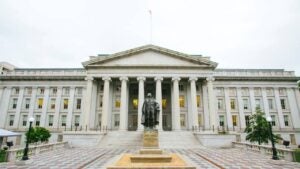Securities and Exchange Commission (SEC): What it is and how it regulates financial markets

The Securities and Exchange Commission, or SEC, is an independent regulatory agency of the United States federal government responsible for protecting investors and maintaining efficient financial markets.
Created in 1934, largely in response to the Great Depression, the agency proposes and enforces securities laws, prevents fraud, democratizes access to information, and acts as a regulator and mediator between the public and companies seeking capital.
By overseeing the activities of those who buy and sell securities and offer financial advice, the SEC prioritizes investors’ interests over those of broker-dealers, asset managers, and corporations. With safeguards in place, the agency maintains confidence in America’s financial markets worth more than $100 trillion.
How the SEC works
Before companies can sell securities to the public, the SEC requires all foreign and domestic businesses to submit a registration statement, including audited financial information, state of operations, risk factors, and other key information. Similarly, financial services firms, money managers and those providing financial advice must adhere to rules governing their conduct.
The SEC seeks to catch potential issues upfront through stringent and periodic legal and financial reviews, minimizing the risk of scams, insider trading, and other abuses. Additionally, the SEC makes all corporate filings available to the public through an electronic database known as EDGAR, which is short for electronic data gathering, analysis and retrieval.
Since all public corporations must disclose material information through the EDGAR system, such as quarterly and annual financial statements, the SEC grants everyone timely access to important disclosures and data. This information is available to investors at least as far back as 1995. With a standardized approach, the SEC seeks to level the playing field for all market participants.
Likewise, the SEC oversees initial public offerings (IPOs) and other avenues for companies and entrepreneurs to raise funds and access America’s capital markets – the world’s most liquid markets. In 2021, for example, 1,033 initial public offerings took place in the U.S. – a record year, according to data from the Nasdaq. These businesses raised a total of $286 billion. In turn, these deals support economic and job growth.
Another vital task of the SEC is maintaining fair, orderly and efficient markets. As technology advancements influence the investment landscape and new investment options emerge, the SEC monitors the activities of all market participants. For example, the agency governs more than 28,000 entities in the financial industry, including mutual fund and ETF providers, ensuring prospectus and other disclosures paint a clear picture of investment risks and other factors.
Who leads the SEC?
The SEC has five commissioners appointed by the U.S. president, with one serving as the chair or the SEC’s top executive. The current chair is Gary Gensler. Each commissioner serves a five-year term, with the option to remain on the job for another 18 months. The terms of the commissioners are staggered, with one appointment expiring each year, meaning a new commissioner is appointed annually. Additionally, the SEC ensures non-partisanship by not having more than three commissioners belong to the same political party.
How is the SEC structured?
The SEC’s headquarters in Washington, D.C., consists of six divisions and 25 offices. Each group has specific functions and responsibilities, such as enforcing actions on securities laws, and revising and implementing new rules, among others.
The six divisions and their duties are:
- Division of corporation finance: Ensures investors receive timely and accurate material information.
- Division of economic and risk analysis: Uses data analytics to detect potential violations, assess market risks, and spot market trends, adding commissioners in the rule-making process.
- Division of enforcement: Pursues investigations into possible violations of securities laws and brings forward civil suits and administrative proceedings.
- Division of examinations: Issues licenses, manages compliance and sets qualification requirements for those working in the financial industry.
- Division of investment management: Regulates fund managers, analysts, advisors, and other professionals in the investment industry.
- Division of trading and markets: Monitors activities from traders, broker-dealers, clearinghouses, and other market participants.
How does the SEC enforce violations?
Although the SEC can bring only civil actions, the agency works closely with agencies in the Department of Justice to enforce criminal cases.
In civil actions, SEC officials pursue monetary penalties such as disgorgement of illegal profits and other sanctions, such as suspending or revoking registration licenses, banning people from participating or working in the financial industry and additional fines.
Apart from conducting internal operations, the SEC relies on its whistleblower program, an initiative that rewards individuals who share information that leads to law enforcement sanctions of more than $1 million. By partnering with the SEC, whistleblowers can receive 10 percent to 30 percent of the sanctions proceedings.
History of the SEC
Congress created the SEC as part of President Franklin Roosevelt’s New Deal programs to rebuild the public’s confidence in the U.S. stock market after the market crash in October 1929.
With billions of dollars lost, banks going out of business, personal bankruptcies, job losses, and other calamities resulting from the crash, lawmakers passed the Securities Act of 1933, which required the registration of securities sold in the U.S. In addition, the legislation sought to increase transparency in financial information and establish laws against market manipulation.
Then the Securities Exchange Act of 1934 established how securities could be traded on the secondary markets, wrote regulations on professional conduct and formally created the SEC.
Since the SEC’s creation, other notable laws that have supported and re-defined its mission include the Sarbanes-Oxley Act of 2002, Dodd-Frank Wall Street Reform and Consumer Protection Act of 2010 and Jumpstart Our Business Startups (JOBS) Act of 2012.
Before the SEC came into existence, supervision of trading and securities laws were practically nonexistent, leading to frenzied financial speculation, shady get-rich scams and other foul play. Today, the agency brings forward multiple civil enforcement suits against individuals and financial institutions every year. It’s involved in every major financial case of misconduct, and the government’s top watchdog on the markets is central to maintaining fair practices.






